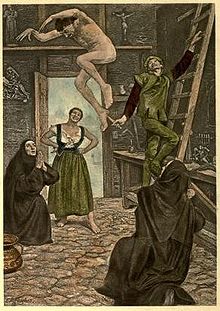
Night the Ninth, Sixth Fable
Watercolor by E. R. Hughes
The Italian Novelists, Volume 3
The Facetious Nights of Straparola (1550–1555; Italian: Le piacevoli notti), also known as The Nights of Straparola, is a two-volume collection of 75 stories by Italian author and fairy-tale collector Giovanni Francesco Straparola. Modeled after Boccaccio's Decameron, it is significant as often being called the first European storybook to contain fairy-tales; it would influence later fairy-tale authors like Charles Perrault and Jacob and Wilhelm Grimm.
History
The Facetious Nights of Straparola was first published in Italy between 1550–53 under the title Le piacevoli notti ("The Pleasant Nights") containing 74 stories. In 1555 the stories were published in a single volume in which one of the tales was replaced with two new tales, bringing the total to 75. Straparola was translated into Spanish in 1583. In 1624 it was placed on the Index of Prohibited Books.
The work was modeled on Boccaccio's Decameron with a frame narrative and novellas, but it took an innovative approach by also including folk and fairy tales. In the frame narrative, participants of a party on the island of Murano, near Venice, tell each other stories that vary from bawdy to fantastic. The narrators are mostly women, while the men, among whose ranks are included historical men of letters such as Pietro Bembo and Bernardo Cappello, listen. The 74 original tales are told over 13 nights, five tales are told each night except the eighth (six tales) and the thirteenth (thirteen tales). Songs and dances begin each night, and the nights end with a riddle or enigma. The tales include folk and fairy-tales (about 15); Boccaccio-like novellas with themes of trickery and intrigue; and tragic and heroic stories.
The 15 fairy tales were influential with later authors, some were the first recorded instances of now-famous stories, like "Puss in Boots". Many of the tales were later collected or retold in Giambattista Basile’s The Tale of Tales (1634–36) and Jacob and Wilhelm Grimm's Grimm's Fairy Tales (1812–15).
Fairy tales
Fairy tales that originally appeared in Nights of Straparola, with later adaptations by Giambattista Basile, Madame d'Aulnoy, Charles Perrault, Carlo Gozzi, Jacob and Wilhelm Grimm.
Footnotes
- Indicates sources which draw a connection between Straparola and the other folklorists for the given tale(s).
- German folklorist Hans-Jörg Uther, in his 2004 revision of the Aarne-Thompson Index, separated this tale under a new type: ATU 510B*, "The Princess in the Chest", wherein the princess hides inside a closet or lantern to escape from an unwanted suitor.
References
- ^ Nancy Canepa. "Straparola, Giovan Francesco (c. 1480–1558)" in The Greenwood Encyclopedia of Folktales and Fairy Tales, 3-volumes, edited by Donald Haase, Greenwood Press, 2008, pages 926–27.
- Opie, Iona; Opie, Peter (1974), The Classic Fairy Tales, Oxford and New York: Oxford University Press, ISBN 0-19-211559-6 See page 20. The claim for earliest fairy-tale is still debated, see for example Jan M. Ziolkowski, Fairy tales from before fairy tales: the medieval Latin past of wonderful lies, University of Michigan Press, 2007. Ziolkowski examines Egbert of Liège's Latin beast poem Fecunda Ratis (The Richly Laden Ship, c. 1022/24), the earliest known version of "Little Red Riding Hood". Further info: Little Red Pentecostal Archived 2007-10-23 at the Wayback Machine, Peter J. Leithart, July 9, 2007.
- Jack Zipes, The Great Fairy Tale Tradition: From Straparola and Basile to the Brothers Grimm, p 841, ISBN 0-393-97636-X
- Giovanni Francesco Straparola (2012). "Introduction". In Beecher, Donald (ed.). The Pleasant Nights. Vol. 1. Translated by Waters, W. G. Toronto, Canada: University of Toronto Press. pp. 90–92. ISBN 9781442699519.
- Uther, Hans-Jörg (2004). The Types of International Folktales: A Classification and Bibliography, Based on the System of Antti Aarne and Stith Thompson. Suomalainen Tiedeakatemia, Academia Scientiarum Fennica. p. 296. ISBN 978-951-41-0963-8.
- Uther, Hans-Jörg (2013). Handbuch zu den "Kinder- und Hausmärchen" der Brüder Grimm: Entstehung - Wirkung - Interpretation. Walter de Gruyter. p. 264. ISBN 9783110317633.
- Le Marchand, Bérénice V. (2016). "Contes en réseaux: l'émergence du conte sur la scène littéraire européenne by Patricia Eichel-Lojkine (review)". Marvels & Tales. 30 (2): 371–373. Project MUSE 655162 ProQuest 1922870374.
- Raynard, S. (1 April 2014). "Contes en reseaux: l'emergence du conte sur la scene litteraire europeenne". French Studies. 68 (2): 279–280. doi:10.1093/fs/knu045. Project MUSE 544012.
- Pirovano, Donato (1 May 2008). "The Literary Fairy Tale of Giovan Francesco Straparola". Romanic Review. 99 (3–4): 281–296. doi:10.1215/26885220-99.3-4.281. ProQuest 196422641.
- Giovanni Francesco Straparola (2012). "Cesarino the Dragon Slayer". In Beecher, Donald (ed.). The Pleasant Nights. Vol. 2. Translated by Waters, W. G. Toronto, Canada: University of Toronto Press. pp. 361–393. ISBN 9781442699533.
Further reading
- Ruth B. Bottigheimer, Fairy Godfather: Straparola, Venice, and the Fairy Tale Tradition (University of Pennsylvania Press, 2002).
External links
- The Nights of Straparola, trans. W.G.Waters 1894. Scanned original color illustrated editions.
- The Italian Novelists (vol. 1–4), trans. W.G.Waters 1901–04. Scanned original color illustrated editions. Note: this edition differs slightly in content from the 1894 edition.
- SurLaLune Fairy Tale Pages: The Facetious Nights of Straparola